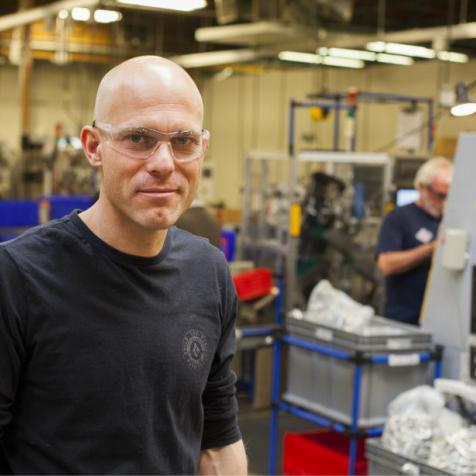
Company Details
Location
Salt Lake City, Utah
Founded
1989
Ownership Type
Private
Employees
700
Products
Climbing equipment
Salt Lake City
Founded: 1989
Publicly traded (NASDAQ: BDE)
Employees: 700
With longtime CEO Peter Metcalf stepping down, VP of Manufacturing Wim de Jager steers a reshoring effort to maintain the climbing titan's anchors atop the outdoor market.
Last year, Salt Lake City's Black Diamond Equipment announced that it was making a strategic "pivot" and was, among other things, bringing manufacturing of climbing equipment back to its headquarters.
"The reshoring of manufacturing is something we've been working on behind the scenes for the last three years," says Black Diamond Vice President of Manufacturing Wim de Jager. He anticipates that most of the company's climbing hard goods -- things like carabiners, rappel devices, ice axes and more -- will be made in the U.S. by August 2015.

"It is the first stepping stone to becoming vertically integrated and having everything under one roof. We're starting to work on efficiencies and automation and other things so that for the next decade we are set up for success," de Jager says.
Along with the pivot toward local manufacturing, the company appointed Zeena Freeman as its new president last August. Freeman, formerly an executive with Sony and Gap, is expected to succeed Metcalf as CEO this summer.
Regardless who's serving as CEO, de Jager says he doesn't anticipate a big change in the company's product portfolio. "How we approach in the market and how we position ourselves -- there she will have the most impact," he says. "We are all climbers, skiers, mountaineers. We are very intimate with the sports. We know how we can move the brand forward in terms of product innovations. In terms of marketing and sales and how we approach new markets, she has a lot of experience that we can benefit from."
Reshoring offers some serious payoffs. "One of the bigger benefits as well is the proximity of research and development and manufacturing all under the same roof. If you have ideas about what you want to innovate and the material you want to work with, it is very beneficial to have manufacturing operations directly at your fingertips."

Adds de Jager: "If you have production going on 5,000 miles away, it's hard to get to and it takes much more time to innovate. We will improve our innovation to market cycle quite a bit by having everything under one roof here. One of the things we recognize is that using, designing engineering and building equipment is of strategic importance to us."
As an outdoor company, Black Diamond also benefits from having Utah as its headquarters. The location helps the company recruit and keep the talent needed to innovate and build the its products, says de Jager, pointing at the Wasatch range,. "Our test facility is just around the corner and it's awesome!"
Black Diamond's soft goods manufacturing, things like clothing and backpacks, will still be made overseas. "Soft goods is such a commodity and there's such a highly specialized blend of suppliers," de Jager explains. "It would not be profitable and nor feasible" to move that manufacturing to the U.S. The economy of scale is what makes it possible."
Black Diamond has optimized operations in China prior to bringing manufacturing back. "We've worked to reduce the amount of labor that we need in manufacturing operations and we've been able to reduce the amount of floor space that we need for manufacturing the goods there," de Jager says. "We've been doing the same in Salt Lake as well. We've reduced the space needed for operations by about 40 percent." That's allowed the company to fit all of its manufacturing equipment in the same space without needing to expand it.

The efficiencies that the company was able to achieve are also essential to the strategy of reshoring manufacturing. "It would be insane to manufacture the same way we produced here before we moved to Asia," de Jager contends. "Business-wise, it was not affordable." In Asia, he adds, "we have a whole supply chain based around the factory in China, and in Asia as well, that supplies service and some parts."
That strategy dovetails into finding sources locally in Utah. "If you buy down in the Valley, it might be a little more expensive, but we don't have to worry about lead time. We can have smaller quantities and the whole thing becomes much more responsive," de Jager says."We can buy parts and components from China, but that still won't deliver the efficiency that we are looking for."
Challenges: "The challenge is to find the right balance, innovate or become sustainable and efficient," de Jager says. "Innovation is a driver and efficiency is a sustainer."

Opportunities: "Climbing is more popular than it ever was before. Climbing gyms are appearing in all kinds of cities the growth rate there is pretty significant," de Jager says. "The snow safety market is an opportunity for us as well as more people start skiing outside the lines."
Needs: Human resources, "We are expanding and that's a challenge for us, as unemployment is low," de Jager says.
